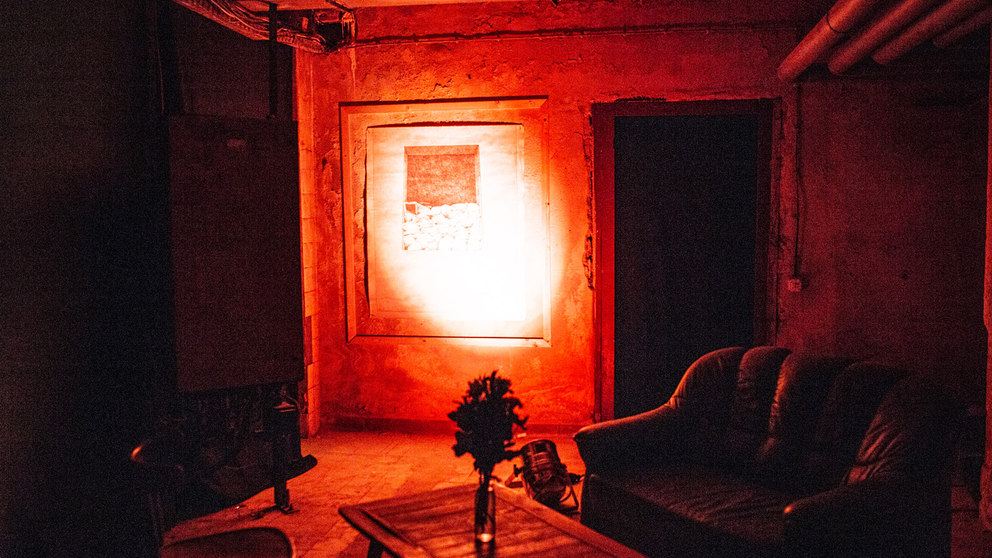
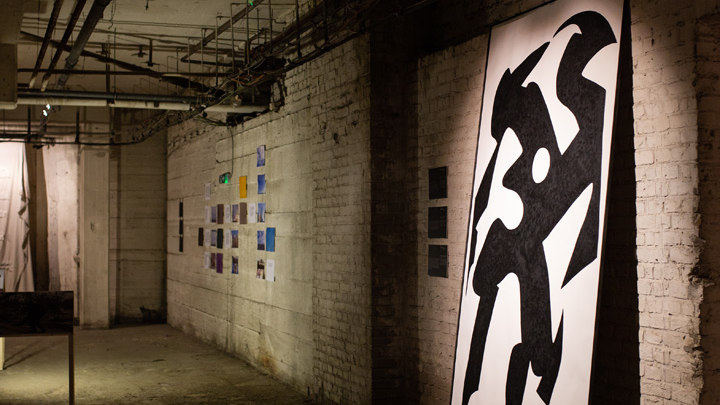
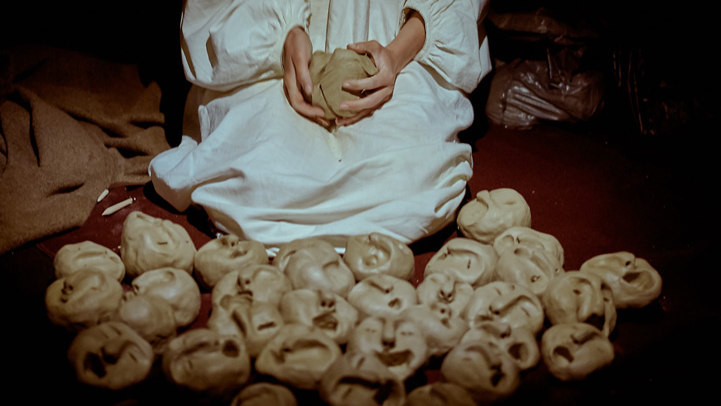
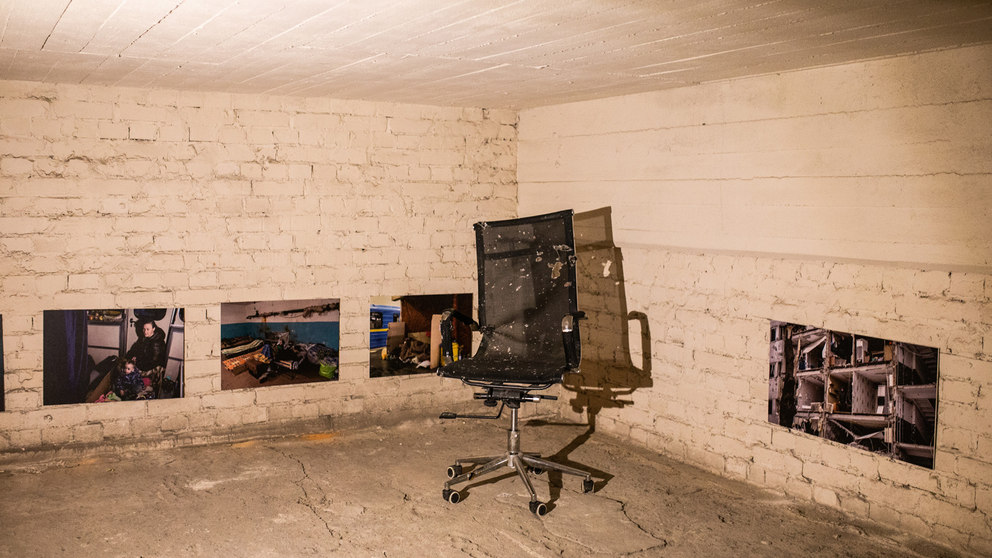
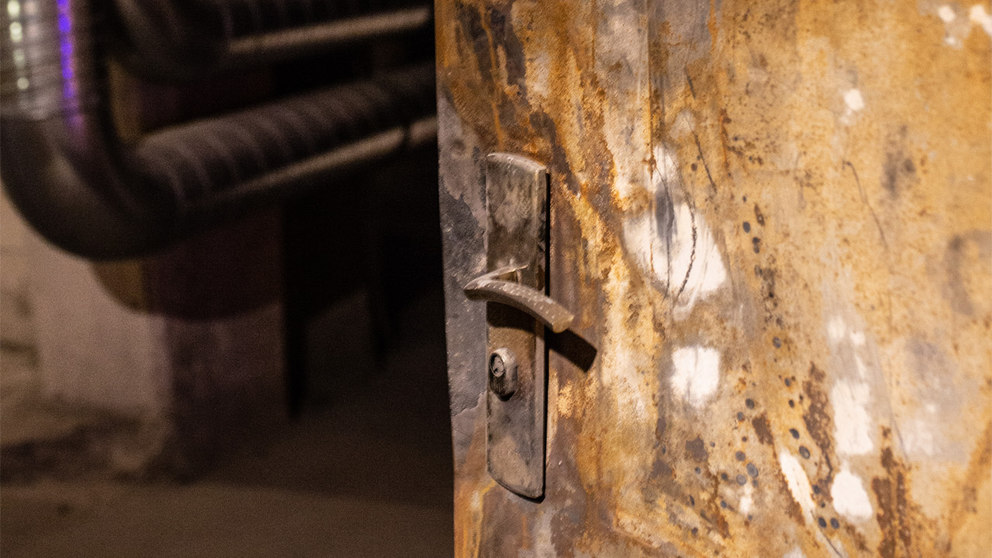
Julio Cortázar's story "The Captured House" ends with its owners abandoning their home. The house of the protagonist, in which he lived happily all his life with his sister, is gradually admired in the rooms by an unknown force. Evil is not shown, not defined, its boundaries are immeasurable.
When the windows of my apartment in Luhansk blew out in 2014, as a reaction to the airwave from an explosion everything seemed unreal, surreal, like in a film. Today, eight years later, we still cannot believe what is happening. But now it is not only our "bedroom and kitchen", as in Cortázar's story, that has been taken over, but our whole house.
After the first world war (1914-18), which was soon followed by the second world war (1939-45) many artists questioned what art should be and whether it should exist at all, if it can not stop evil. Why does one need beauty if it can't fight the destruction? Some post-war artists, such as Anselm Kiefer and Gerhard Richter, had to process this war experience through time, go through the pain, accept the inevitability, and return to a practice that expressed the essence of what was happening. What can poetry and music be like after the war? What should theatre be like?
Art has different roles, including therapeutic ones. During World War II, Myra Hess gave regular lunch concerts at the National Gallery in London. She played the piano until the windows of the gallery were closed so that the light from the lamps would not slip into the street and the Nazis would not see that there were people there. It should never happen again, we said. It’s incomprehensible that civilians are being deliberately targeted. But this is exactly what is happening in Ukraine now.
In the eyes of those out of Ukraine, war exists through the screen of a television or computer, perhaps a smartphone. That is, in the format of 8x12 cm. But for us it is actually happening in the widest format imaginable. This is not a computer game, nor a good blockbuster apocalypse. This is the reality.
The horror is that there is nothing new in war, writes Susan Sontag in her essay "Looking at other people's suffering." Mankind has been at war forever. And if you look at history everywhere, rather, war was a terrible norm, and the world was an unattainable dream. But in the twentieth century, everything changed. With the advent of democracy and humanistic theories, we looked at wars differently. We looked at them not as an inevitability, but as a barbarism that must be stopped immediately.
But we also look at wars with cinematic eyes. This is a contradictory result of the development of the culture of our time. Our conditioned imagination compares war to a blockbuster. Reality and fiction blur. Being far from the war and looking at it from TV screens and monitors, we perceive it as something unreal, distant from us. That we can switch over or walk away from at any time. The stark difference is that Ukrainians who remain in Kharkiv, Mariupol, Melitopol and other places of hostilities now can not go anywhere. Many do not have the basic needs for life.
The historical view of the war has been to glamorize it. To make heroes. As the artist Fiona Banner has said, we are both seduced and repelled by war and its machinery. Military photography is designed to shock, surprise, stop the eye and be forever etched in the memory. Photojournalist reports from the war, adapted for the news, are a form of art, shown in galleries. The image of war is intended for the viewer–this is, in general, a constructed reality. Reality, the most bloodthirsty part of which is shown in pieces. It rarely gives us a complete picture of the war, and even less often brings us closer to it. It informs us.
The aim of the exhibition "The Captured House" is not just to inform and arouse sympathy. The project is designed not just to show the horrors of war and to tell that the bloodthirsty massacre and genocide of Ukrainians is happening in the heart of Europe right now.
The exhibition consists of documentary and indirect evidence, essays, interpretations, memories of recent events, archives of foreboding, as well as items that retain the warmth of the hands of the owners. This exhibition is a testament to the war. But not cruel, not straightforward, ambiguous. It is now a show, but a space for response and decisive action.
Art is another way to talk about war. But it is also a field for free thought, freedom of speech, a territory for critical thinking and an alternative view. An area that is so necessary for intercultural dialogue and for the development of the society that Europe has been building for 80 years. Society of peace, justice and equality.
The exhibition includes stories of civilians and artists, and their unique archives of memory. In this sense, it is very personal. Each artist addresses each viewer. One to one.
The participants of the project are Ukrainian artists: Vlada Ralko, Alevtina Kakhidze, Oleksiy Sai, Masha Shubina, Igor Gusev, Danilo Galkin and others. Artists urge the viewer not to look but to think and feel. See deeper than the surface. And unlike the news, which has its own role, the artist interacts pointwise, subtly and directly with everyone who came, telling the viewer his story.
Mostly the participants of the exhibition are artists who stayed in critical areas of the conflict, or at the time of creating the artworks were in their cities, experiencing and comprehending their own experiences. Some began working immediately, some remained dumb in the face of war until they were safe.
The artists have different missions and motives. But they remain true to their purpose. Someone interprets what he sees around every day as Anton Logov. Someone is documenting an immigration road trip, like Hanna Hrabarska. Alevtina Kakhidze tries to live a "normal life" and continues to keep a visual diary in her village, Muzychy. Vlada Ralko chooses a specific theme, such as "aggression and imperialism" and therapeutically depicts the horrors of war with a ballpoint pen.
Art often needs time and distance to be born from reflection. To see the scene from the horizon, to comprehend it, to think, to propose an artwork passed through oneself. But we do not have this time. Our house is occupied now. Our cities are on fire, and our children are dying every day because the Russian army is dropping bombs on Ukrainian theatres and music schools where families are hiding, Indiscriminately killing civilians, families, in their retreat in Irpyn and Bucha.
Eight years ago, the "three rooms of our house" were captured: Crimea, Luhansk and Donetsk, and we held the enemy as long as we could, hoping to return what belonged to us. Today we are fighting for every life and every inch of our land. But we are also fighting for the truth, honour and identity that the Russians are trying to destroy.
Despite our faith, we also know that absolute evil will stop at nothing, and there are no geographical or ethical boundaries for it. And if it wants to take over our whole house–Europe–it will not stop.
This is not just our war. This is the war of the whole civilised world, which we defend and stand on as a shield, a shield of people. Heroes who remain in Ukraine defend the country, and help to survive. And creative minds that continue to call for common sense not only through the direct image of war, but also through our cultural codes, the roots of our common identity, Ukraine's relationship with Europe and our common values. Let this project become not a stream of "bad news from Ukraine", but your personal conversation in your kitchen to your heart's content, with every Ukrainian whose life is in danger in our common "The Captured House".
Kate Taylor,
curator
The 9th century – the Kyivan Rus federation is being formed with its capital in Kyiv on the territory of modern-day Ukraine. For the next few centuries it would become one of the most powerful countries in the world, and the Kyiv princes would come together with all of Europe.
I live in Kyiv. It’s a large city on the crossing of trade routes from North and South, from East and West. We’ve been living in peace for several years now. Let it be that way forever.
1187 — The first mention of Ukraine in a written source.
I’m a Christian, a blacksmith, I live in Ukraine. It’s a prosperous and fertile land of happy people.
12th century: Yuri Volodymyrovych, prince of Kyiv founds the settlement of Moscow
We came back from a quest to the Northern lands, where we found a new settlement, headed by our prince. Finno-ugric tribes live there rather than Slavs like us, but I hope we can live in peace. It’s so good to see Kyiv after that wilderness!
1648 — free warriors of Ukraine, cossacks, reinstall statehood on these lands. They raised the country in battle and created something unique, a democratic politico-military establishment.
I’m not going to take this abuse anymore. I’m going to run off to the cossacks, become a part of this brotherhood and will help build the Ukrainian state!
1721 – Petr I, Tsar of Muscovy, renames the Tsardom of Russia to the Russian Empire.
Reportedly, the Tsar of Muscovy ordered his empire to be called Russia from now. But “Rus” and all the derived words come from the Ukrainian lands, even the Byzantine emperors called us that! Why would they need our name? To look more ancient? Weird.
1765-75 — Catherine the Great, Empress of Russia, dismantles the autonomy of Ukraine and destroys the cossacks.
Hard times are upon Ukraine-Rus. The Empire is banning our culture and even our history. And cossacks are outright slaughtered.
19th century — The Russian Empire bans Ukrainian language and starts claiming Russians and Ukrainians to be one nation.
Muscovites came, took our books, banned folk songs, and declared that we are one nation. That’s if I understood them correctly, as they spoke their language, not Ukrainian.
1917 — The Russian Empire collapses as a result of World War One. Headed by Lenin, communists kill Tzar Nikolai II. Ukraine declares independence.
Everyone is attacking us one after another, Russians, Germans, Austrians. I haven’t heard from my father and brother for a long time now. Last time they sent me a letter from Kyiv where the independent Ukrainian state was declared by the will of the people.
1918 — Ukraine is occupied by Russia again. Lenin denies the presence of Russian troops and tells the world it’s a civil war.
Firing squads, blood, robberies. I don’t know if Ukraine can hold on. I signed up as a volunteer.
1922 — the USSR is formed from all countries occupied by Russia.
Lenin has just declared the creation of a free communist state. I can’t understand why people are forced to join it if it’s claimed to be independent?
1920s — 30s — hundreds of Ukrainian rebellions against the occupation, from military to farmers armed with scythes and pitchforks.
I couldn’t believe communists committed such atrocities before I'd seen it for myself. Enough of this, we decided to fight for our rights! I heard people rebel all over Ukraine, so we have hope for victory!
1932 — 1933 — USSR creates a man-made famine (Holodomor) against the Ukrainian people. Over 3.5 million people died.
Communists came and took all our grain and shot those who refused. We ran out of food a long time ago. Birds no longer sing, we ate them all. Bodies of my friends are lying on the streets. We are eating tree bark and anything made of leather. We are getting weak. Can anyone help us?
1937-38 — The Great Terror in the Soviet Union. Ukrainian intelligence is slaughtered, hundreds of writers, artists and musicians are murdered. Overall number of Ukrainians deaths is estimated at over 100,000.
Stalin has declared war on the people of own country. Strangers in black cars come at night and take people away, never to be seen again. I’ve heard of a list of so-called enemies of the state — in May 1938, 563 people were executed by firing squad in just one day.
1941 – Hitler attacks the USSR and occupies the whole of Ukraine.
Our country is ruined again. Will war ever end?
1942 – The Ukrainian Insurrection Army launches and fights against Nazis.
My brother signed up with the rebels. He told me he’ll fight the Germans for the independence of Ukraine and left. I’m scared.
1944-1956 – After the retreat of the German army, the Ukrainian Insurrection Army continues fighting with the USSR for independence. This unequal battle will be raging on for years.
Brother visited us last night. He’s covered in scars from head to toe. He told me how other patriots and he are hiding in the forest to make the USSR recognize Ukraine’s right to live independently. When I finish school, I want to join rebels too.
1960-1980 — peaceful dissident movement carries on the resistance. Most of them are either killed or jailed.
Oles was arrested. Petro was arrested. Alla was murdered. Viacheslav was arrested. Levko was arrested. Vasyl died behind bars. Nadia was arrested. Anybody who dares oppose the dictatorship just disappears.
1991 — Ukraine declares independence. It is supported by more than 90% of citizens at a country-wide referendum.
I’m crying tears of happiness! Ukraine declares independence for god knows which time now, but I’m sure it will be different now! We’ll keep our freedom!
1994 – Ukraine becomes the first country in the world to willingly trade nuclear weapons for guarantees of safety and territorial sovereignty.
I had an argument with my neighbor. He said we shouldn’t have given away the third nuclear arsenal in the world. I told him “why would we need that if we’re a democratic independent European state? Why would anyone attack us?”
2004 – Orange revolution in Ukraine. Ukrainians protest against the election being stolen by pro-russian Yanukovich. Elected president Yuschenko declares European integration as a primary goal
I have never felt such unity. We all stand together, all for one. And we win. What a marvellous feeling!
2005 — Putin claims the dissolution of the USSR to be the greatest geopolitical catastrophe of the 20th century.
Watched Russian president talk on TV. Seven decades of totalitarianism, oppression, repressions and murders and he calls the end of that a catastrophe? Something is wrong with that man.
2013-2014 — Yanukovich refuses to proceed with Ukraine’s European integration program. Ukrainians go out on the streets. The Revolution of Dignity begins. Peaceful protesters are being shot. 107 Ukrainians are murdered.
Blood is on the streets. Maidan stood and won. Those sacrifices won’t be in vain and Ukraine will keep on moving to its future of a free democratic European state.
2014 – Russia occupies Ukrainian Crimea and starts the war in Donbas.
My Crimean relatives told me that armed people wearing military uniforms with no insignia staged a “referendum” at a gunpoint. Friends from Donetsk said the same people started shooting. Am I in a nightmare?
2015-2022 – With help of European intermediaries, Ukraine attempts to peacefully take back territories temporarily occupied by Russia.
Peace talks. They go on and on. Meanwhile the war in Ukraine has become the longest one that Europe had in decades.
February 24 2022 — Full-scale Russian invasion of Ukraine begins.
I woke up from the explosions. My country is on fire. I’m going to war. We will win.
Anticipation
The war in Ukraine did not begin on February 24, 2022. Nor did it start in 2014 with Russia's annexation of Crimea and Donbas. In a broader sense, this war has been going on for centuries. Ukraine fights for its identity, authentic culture, and its own history, which Russia does not recognize, appropriating and destroying everything Ukrainian.
However, the starting point of this project was set in 2014. The war in Ukraine has been going on for 8 years, and it escalated on Europe's doorstep on February 24, 2022. During these 8 years it was possible to give birth to a child and send it to school, build a career or completely change your life. Or try to make sense of what is happening.
Looking at these events from an artistic perspective, we see how the authors feel the historical changes. They stand on the horizon of events, express a collective voice through personal experience, and offer us a panorama of views to try to comprehend what is happening today. In Ukraine as well as in the whole civilized world.
Aggression
Journalists from international agencies in Bucha and Irpin after their de-occupation by Russia were shocked by the unprecedented brutality and horrors of the war. However, they were most impressed by the fact that the lives of people who died in horrific circumstances are no different from the lives of developed western countries. That this is not a post-Soviet echo, on the ruins of which Ukrainians built their future, but wealthy housing, modern architecture and a developed economy. This is the same life as in the countries from which they came, but destroyed.
There are no Russian equipment and weapons at this exhibition. We do not show aggression directly, because everyone can see it by turning on the news. We are talking about the consequences of this aggression, which, like a hurricane, destroyed everything and left us with the question. The question is, how is such evil possible at the same time in a world of diversity, inclusiveness and justice? And this evil - right here - in a few hours of flight. If only planes - another attribute of the modern world - still flew in Ukraine.
The tragedy in Bucha became the point where civilized countries crossed the rubicon of the old world and joined another. The values of the Western world have been building for at least 80 years. But what are they worth without people? Because nothing could protect the people who believed in them.
Fearless
The war happened not only to Ukraine as a state, it happened to Ukrainians. With each individual. For each and everyone of the 45 million Ukrainians, life will never be the same.
There are those who left and those who stayed. Some have decided to help others, some need help. But one way or another, the lives of civilians have been destroyed and we are all trying to comprehend these destructions, the consequences of which are still unknown.
Everyone's life deserves a grand exposition. In this project we tell personal stories of Ukrainians, and look at the terrible reality through artistic instruments.
In some twisted, horrible sense, the war is fascinating. No scenery and special effects of Hollywood movies can compare with the rehearsal of the end of the world, which was shown to us in Ukraine today.
At the same time as Russia is destroying cities to erase Ukrainians from the historical map, new meanings and identities are forming within the country. This is the basis of opposition to the enemy, the unity of Ukraine and our main force. It is here, in these ruined houses, kindergartens and theaters, that a new Ukrainianness is being formed. Understanding who we are as a nation, but more importantly, who I am as a civilized person.
Newborn ordinary
Home is a safe place, extension of your habits, comfort. We all want to go home after a long day of work or travel.
Since the beginning of the war in Ukraine, more than 7.7 million people have been forced to flee their homes. However, tens of thousands are currently returning to Kyiv alone. Ukrainians respond to the irresistible desire to return home. Despite the fact that home is no longer a safe place for them.
But life has changed not only for those who left, but also for those who stayed and live in new conditions, adapting to the harsh reality. People sleep on the floor in the subway and gyms. Ten of them live in a 15-square-meter bunker. Cooking on a campfire near a ruined house. Drink rainwater. Children, meanwhile, continue to study online. Civilians volunteer, protect the lives of their loved ones, help not only their families but also others. Life goes on.
Among those who remained in the hotspots are artists. Some of them did not immediately find their voice in the middle of the war, and some are yet to find theirs. In this project, we show those who felt the need to talk about the war through their personal stories and telling the stories of others.
Identity
The new identity of the Ukrainian people is being formed right now. The voices of artists are more important today than ever. After all, they do not record events, but what is happening inside the Nation's DNA, pass it through themselves and show not things themselves but their essence. People need more than just facts about the war. Inside, there is a struggle of feelings and emotions that are impossible to cope with. Art helps to understand yourself, to find feedback. Through artistic interpretations, symbols and cultural codes, people better understand both traditions and new values.
Art is, among other things, a field for free thought, freedom of speech, a territory of critical thinking and an alternative view. This exhibition immerses us in the space of artistic interpretation, but also appeals directly to each viewer to talk face to face with their values and their ideas of peace, justice and equality.
Both in Ukraine and around the globe.